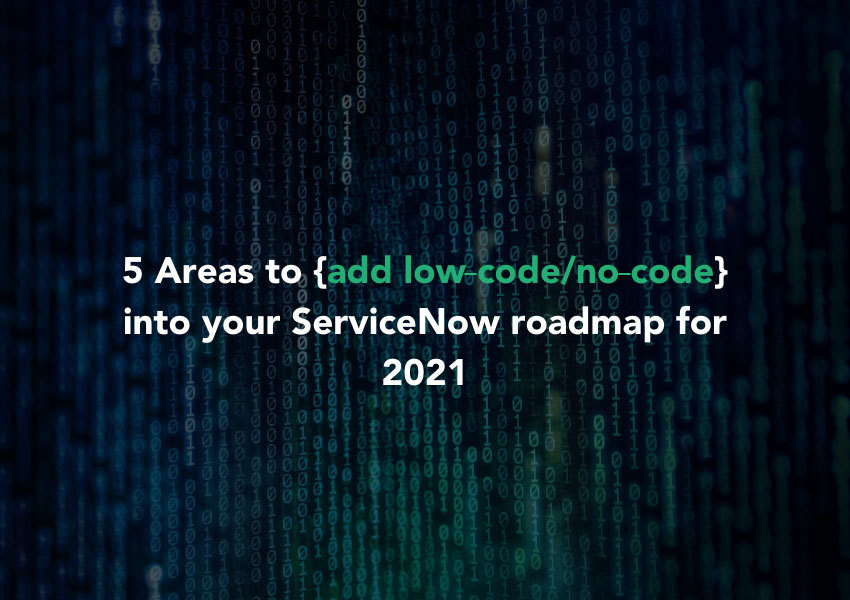5 Areas to add low-code/no-code into your ServiceNow roadmap for 2021
- Share

5 Areas to add low-code/no-code into your ServiceNow roadmap for 2021
There’s a new buzzword making it’s way around the internet, “Citizen Development.” Citizen Development involves low-code or no-code applications that allow personnel outside of the traditional IT department to create forms, workflows and applications. According to Gartner Research, Published on BusinessWire, “by 2023, over 50% of medium to large enterprises will have adopted an LCAP (the low-code application platform) as one of their strategic application platforms.”
Gartner’s magic quadrant has named ServiceNow as a leader in their 2020 Enterprise Low-Code Application Platform (LCAP) report, and as a tool organizations already count on as a leader in Enterprise and IT Service Management, many companies and decision makers are looking to ServiceNow to pave the way for citizen development, rapid delivery of low-code/no-code applications and more.
Here are 5 areas to add low-code/no-code into your ServiceNow roadmap for 2021
1st – Reporting
ServiceNow’s low-code approach starts with the area of most interest to leadership and management - reporting. Gone are the days when you’d need to hire a SQL developer, report writer, and marketing specialist to gather, populate and present a report. Reporting in ServiceNow is driven using a wizard, allowing you to select the table, the visualization, the columns, and even filtering data using a What You See is What You Get GUI editor. No complex scripting, SQL, joins, or DAX required.
Using the no-code reporting interface in ServiceNow you can produce a variety of visualizations for data sets in ServiceNow, quickly generating drill-down reports as well as high level trend charts directly in the platform. As a benefit, these no-code reports can be extended further by scheduling them to email, publishing them to public URLs or even to live-updating dashboards accessible by your users.
2nd – Catalog Items
ServiceNow’s catalog items and record producers are known for their ability to replace dated and manual processes such as PDFs, emails and web forms. No longer will you need a dot net developer, front-end UX developer and data engineer to create forms, validate input and feed that input into other workflows. Using the out of box features low-code features of the ServiceNow platform you can create powerful intake forms to feed your tables, workflows and reports.
A majority of the most powerful features, including dynamically hiding, showing and mandating fields, as well as validating complex regular expressions can all be done with no-code. Examples of no-code or low-code elements in designing forms include catalog UI policies, variable validation regex and reference fields. As an added benefit, these functions all run client-side, avoiding complex ajax calls and potential issues with asynchronous execution.
3rd – Flow Design
ServiceNow’s low-code approach is on full display using the flow designer. ServiceNow overhauled the legacy workflow engine to create a truly citizen-developer friendly, no-code workflow engine within the platform. Flow Designer allows for simple drag and drop actions, including inputs, outputs, and a concept called “data pills” which allows you to put together complex workflows in the platform using no-code or scripting.
Using the flow designer interface your business personnel or technology personnel can rapidly develop workflows, test them against existing records, and even integrate the platform to other cloud and on-premise tools using the ServiceNow IntegrationHub.
4th – IntegrationHub
ServiceNow’s IntegrationHub builds upon the low-code no-code framework of the service catalog and the flow designer. You no longer need to have a pair of specialized hands for every tool in your environment, and you don’t need to maintain complex ebonding, ETL or ESB integrations using tools such as Workato or Talend. Instead, you can use the concept of a “spoke” right within flow designer to connect ServiceNow unidirectionally or bidirectionally to other platforms and tools.
Using IntegrationHub you can connect “Spokes” into your workflow, avoiding dozens of hours creating a bespoke solution to integrate your ServiceNow to other tools such as Microsoft Active Directory, Atlassian JIRA, Amazon AWS, GitHub and dozens of other ServiceNow technology partners.
5th – Virtual Agent
Similar to flow designer and IntegrationHub, ServiceNow has invested heavily in the virtual agent and chatbot ecosystem. The virtual agent designer allows you to create complex conversation trees and powerful automations from within the platform, no scripting required. A deep understanding of machine learning, natural language understanding or other complex technical specialties Is no longer required to create a functional chat bot in the ServiceNow platform.
Use the Virtual Agent to automate basic requests, such as resetting passwords, requesting the location of key HR policies or even providing directions to your sites. If you’re looking for a deeper and more integrated experience, ServiceNow’s NLU (natural language understanding) models can be implemented, or you can connect ServiceNow to an existing NLU such as Watson.
Conclusion
Forrester Research predicts that by the end of 2021, 75 percent of development shops will use low-code platforms.ServiceNow has been making big investments into the low-code, no-code space for quite some time. The biggest names in IT research, Gartner and Forrester agree, these investments have paid off and ServiceNow is the leader in the space. Are you implementing low-code or no-code in your environment today?
Here at GuideVision, we help organizations big and small leverage ServiceNow to make the most of their digital transformation. We are exclusively devoted to ServiceNow, providing custom ServiceNow consulting, development and advisory services. If you’re interested in learning how GuideVision can support your organization and drive simpler, safer, mobile-native implementations of ServiceNow low-code or no-code applications, please reach Contact us today to schedule a consultation.
Subscribe to our newsletter
Thank you!
You have successfully subscribed to our newsletter.
